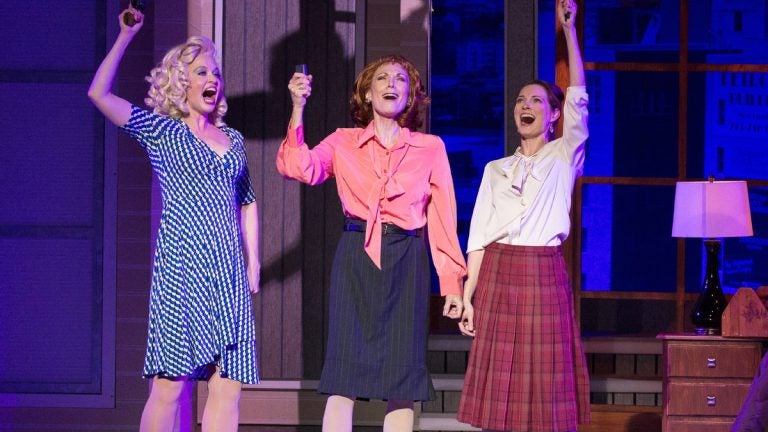Review: Punching in, at a greatly revamped ‘9 to 5’
Listen
The three leads in Walnut Street Theatre's main stage production of '9 to 5: The Musical' -- from left, Amy Bodnar, Dee Hoty and Amanda Rose. (Photo courtesy of Mark Garvin)
If the smooth, feisty production of “9 to 5: The Musical” that opened on the Walnut Street Theatre’s main stage Wednesday night had been the same one on Broadway five seasons back, it would’ve lasted a lot longer than a measly 172 performances.
The Broadway show had some sprightly dancing and singing, but as a whole it came off as lifeless – I remember it mostly as a blur. So why did I sit thinking, at the Walnut opening Wednesday night, gee, how did this show get to be lively and a whole lot of fun?
Because it isn’t the same show.
“9 to 5” has had a shot of theatrical Botox. After it closed on Broadway, its creators and the producers of its national tour decided to do the work that should have been done on the show before it opened in New York. But they couldn’t because “9 to 5” opened on Broadway without a run beforehand somewhere else. So the “9 to 5” team reversed the normal process, in which a regional theater company would have produced the musical, the creative team would then work to make it better, and interested producers might take it to Broadway. In the post-Broadway re-do, the creators punched up the dialogue (the script is by Patricia Resnick), cleaned up three rambling dream sequences and killed a needless song that sat heavily in the second half.
Now, instead of an old washcloth what you’re getting at the Walnut is a new set of towels based on the washcloth’s design. And thank heavens for that – I wasn’t looking forward to seeing the show again, but by the time intermission hit, I was pumped. “9 to 5” still has some of the same downsides as it always had – the characters, as in the 1980 hit movie, are stick-figure stereotypes; the plot ties itself up so neatly that it feels packaged by UPS instead of a team of artists; and many of the songs written by Dolly Parton, who starred in the film, begin to sound as though we heard them before, maybe 15 minutes ago.
But now, the show has Dolly Parton, too, unlike its Broadway version. She appears above the Walnut proscenium in a recorded version that blends with the timing of the live performance. She’s inside a clock, and when the clock’s face isn’t on, a bubbly Parton is there instead to tell us who the main characters are and, at the end, to summarize the situation.
The plot has three women – an office supervisor and two other employees – getting back at their repressive, sexist-pig company chief. The three women at the Walnut are Dee Hoty as the officer supervisor at Consolidated Industries, Amy Bodnar as a blond bombshell who works there, and Amanda Rose as a newly divorced woman in her first job after years of “taking care of a husband who ran off with a 19 year old,” she tells us. (You can see where this show is going when it comes to men.) Each of the three leads has striking moments in the song-and-dance sun, yet together they give the production the feel of a tight ensemble piece.
One of the failings of the Broadway show was that its cast came across as people in a Broadway show. At the Walnut, the cast comes across as a collection of disrespected, harassed workers — what they’re supposed to be. Philly veteran actress Mary Martello is the frumpy aide who secretly has the hots for her execrable boss (she nails a number, sensationally, that will surely have the house hooting with approval nightly). Paul Schoeffler appears downright evil in his comic portrayal as the company chief. Ben Dibble, another Philly regular, is the company’s amiable financial chief.
Bruce Lumpkin, the Walnut’s director of choice for musicals, stages “9 to 5” without a downbeat moment. Michelle Gaudette’s choreography has this office staff shimmying, and Colleen Grady’s costumes put them into the late ’70s, when the show’s set. The noticeable misstep in the production comes in Will Pickens’ sound design which, in tandem with some high-volume orchestrations conduced by Douglass G. Lutz, blur too many of the lyrics Dolly Parton wrote so well.
Last spring, Robert Andrew Kovach designed a swell set of 1950s offices for the Walnut’s production of another work-themed musical that had a lot to do with sexism, “How to Succeed in Business Without Really Trying.” For that, he used blocks of colored light to highlight the office walls. Now he’s back in “9 to 5,” which takes place about two decades later, with another impressive set that uses blocks of colored light more toward the ceilings. Same effect, different era. But the problems that exist in these workplaces have remained pretty much the same.
“9 to 5” runs through Oct. 19 on the main stage of the Walnut Street Theatre, at Walnut Street between Eighth and Ninth Streets. 215-574-3550 or www.walnutstreettheatre.org.
WHYY is your source for fact-based, in-depth journalism and information. As a nonprofit organization, we rely on financial support from readers like you. Please give today.




